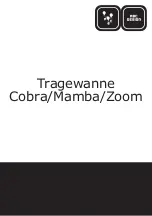
8-20
L90 LINE CURRENT DIFFERENTIAL SYSTEM – INSTRUCTION MANUAL
PROTECTION SIGNALING SCHEMES
CHAPTER 8: APPLICATION OF SETTINGS
8
The directional comparison unblocking scheme allows a window of opportunity for tripping the breaker fast if the
permissive signal gets attenuated by the fault to a level below the receiver's threshold. The guard signal is monitored, and
the relay is allowed to trip for a loss of guard without receipt of the permissive signal, if the relay sees the fault in the
forward, and not reverse direction by means of the forward looking distance zone 2 and ground directional forward, if
configured, and reverse looking distance zone 4 and ground directional reverse, if configured.
The scheme is active and ready for operation when the
DCUB BLOCK
setting is “Off” the
DCUB SCHEME FUNCTION
setting is
“Enabled”. The user can disable or block the scheme by assigning any FlexLogic operand to the
DCUB BLOCK
setting. This
operand can consist of any pre-defined logic, including a pilot cutout switch connected to any contact input of the L90.
With this pilot cutout switch and the pre-defined logic state on and assigned to
DCUB BLOCK
, the scheme is disabled. The
directional comparison unblocking scheme supervises the operation and keying of all scheme functions. The lockout
feature of the scheme also supervises all scheme functions. All timers are fully adjustable, with typical values indicated.
Lockout of the directional comparison unblocking scheme is established as follows. Lockout of the scheme is started for a
time duration set by
DCUB LOG TRIP WINDOW
setting if:
•
The scheme is enabled and not blocked (that is, the scheme is active), and
•
no permissive RX signal is received, and
•
any loss-of-guard signal is received
Lockout is sealed-in through an AND gate with the directional comparison unblocking scheme active and any loss-of-
guard through
GUARD HEALTHY RESET DELAY
timer. The scheme thus remains blocked during longer loss-of-guard or
channel conditions for any of the configured channels. The
GUARD HEALTHY RESET DELAY
timer ensures that the scheme
remains locked out slightly longer after the loss-of-guard signal(s) is reset. This allows for all channel(s) stabilizing and
contact denouncing. This timer determines how long the logic waits before enabling the directional comparison
unblocking scheme when the communications channel is restored.
Operating of the directional comparison unblocking scheme consists of two parts: normal operation and loss-of-guard
operation.
8.5.7.2 Normal operation
Normal operation picks up under the following conditions:
•
The scheme is enabled (
DCUB FUNCTION
is “Enabled” and
DCUB BLOCK
is “Off”), and
•
any permissive signal is received with its associated loss-of-guard signal (for example,
DCUB RX1
and
DCUB LOG1
), and
•
a fault is seen in the forward zone 2 distance elements or ground directional forward function (if configured), and
•
the reverse zone 4 distance elements or ground directional reverse function (if configured) did not pickup to set the
transient blocking, and
•
the scheme is not locked out
If these conditions are met, the trip table is run, operating the scheme and asserting the
DCUB OP
FlexLogic operand. The
trip table with the aid of the local phase selector and received RX signals determine what tripping operands are operated.
During normal operation, the loss-of-guard signal is seen momentarily before the permissive
DCUB RX
signal is received for
each channel being operated, as the channel transitions from guard to permissive frequency, but the scheme operates
instantaneously after any
DCUB RX
signal is received.
8.5.7.3 Loss-of-guard operation
The loss-of-guard operation picks up under the following conditions:
•
The scheme is enabled (
DCUB FUNCTION
is “Enabled” and
DCUB BLOCK
is “Off”), and
•
any loss-of-guard signal is received without its associated RX signal, and
•
a fault is seen in the forward zone 2 distance elements or ground directional forward function (if configured), and
•
the reverse zone 4 distance elements or ground directional reverse function (if configured) did not pickup to set the
transient blocking.
If these conditions are met, then the
DCUB LOG PICKUP DELAY
timer is started. After this timer times out, the trip table is run,
operating the scheme and asserting the
DCUB OP
FlexLogic operand. The trip table with the aid of the local phase selector
and loss-of-guard signals determines what tripping operands are operated. The
DCUB LOG PICKUP DELAY
timer allows for
any and all channel(s) to transition from guard to permissive before operating due to loss-of-guard in the presence of a
















































